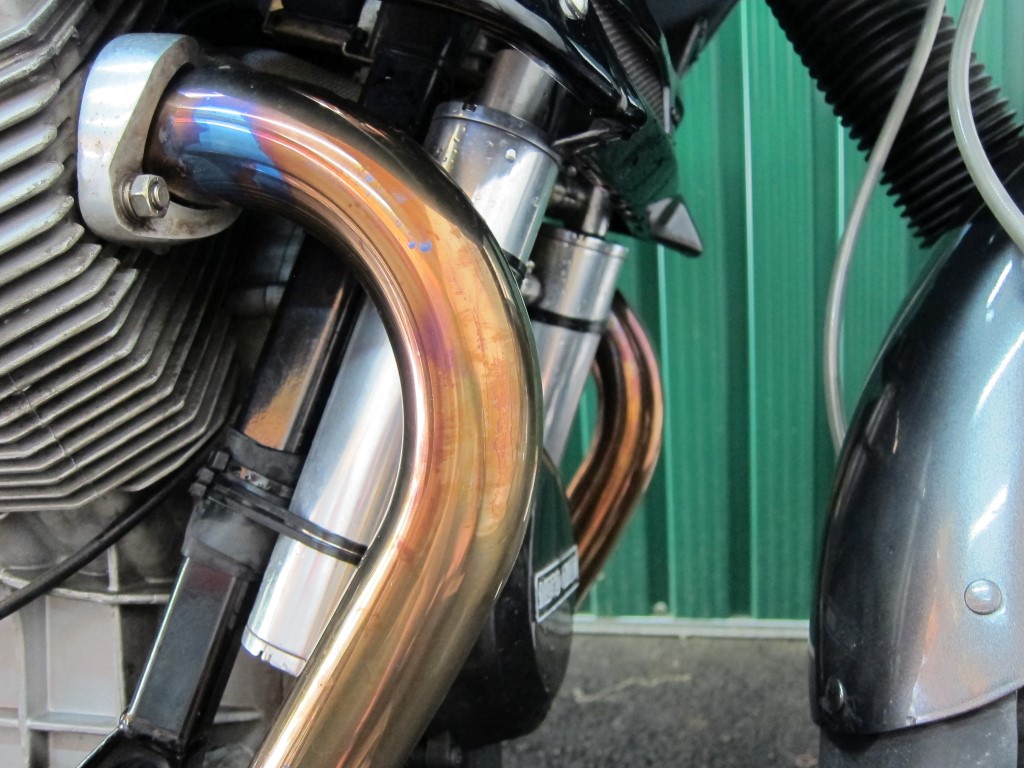Rust in the oil
Moto Guzzi Quota 1000 and Quota 1100 ES models
Created:
Updated:
Martin Standing sent me several articles directly related to his Moto Guzzi Quota 1100 ES. I am happy to host his articles. Enjoy!
Okay, so this one is a really horrible problem! It also seems to also effect other Guzzi models, from what I have read. The oil separator is an integral part of the frame mounted between the top frame sections, just behind the head stock assembly. The theory is that the gases (from piston blow past) and water vapour is sucked through the air filter box and burnt in the engine. The oil mist is collected in the separator tank and runs back into the engine through two pipe that run to the cylinder heads. Unfortunately, the water vapour mostly condenses out and forms an emulsification with the oil, which runs back into the engine. When the water has a chance to stand in the tank then the steel rusts and the rust also runs back into the engine. I believe my Quota was in not used for some time and collected a lot of rust in the separator. Soon after purchasing the bike I stopped during a ride and noticed the oil light start to flicker and then to light up when ticking over. As soon as I noticed this it was time to investigate. Taking the oil sump and the rocker covers off showed that lots of rust and muck had run back into the engine. The oil pick up screen is not very convincing being a coarse plastic filter screen, which doesn't even seal particularly well around the perimeter. The muck had been pulled up into the oil pump and I suspect ruined the pump. I ordered a new oil pump and then sought to rectify the problem. The first quick fix was to mount fuel filters (not the paper type) into the return lines to make sure that the muck was not getting into the engine. However, I was shocked with just how much emulsified oil was present in the filters. It is really not desirable to have this coming back into the engine, so over the winter the plan was to make a proper solution to the problem.
The solution
There are many variations that can be applied to a new oil separator, but I decided that the connection to the air-box and the return to the engine would be cut. The connection to the air-box had two reasons, I wanted to see what was going on and also the large bore engines have a very poor combustion chamber and anything affecting the fuelling was a variable I didn't want to have when sorting the fuelling problems I had. So the system I have made is a total loss-system from the breather. The first test was just one oil separator from a car accessory shop and I mounted this to the frame tubes by the header pipes. With some T-pieces I connected the main breather pipe to the two cylinder heads and ran this on to the oil separator. On the engine breather outlet there is a one way valve that stops the engine sucking back through the breather. I wondered whether connecting the two cylinder heads, which to some extent short circuits this, would have a negative effect. However, I think the bore is so small as to not really effect it, at the end of the breather pipe a positive puff can be felt. The output from the separator I ran back between the cylinders on as higher route as possible (just under the air-box) and exited the pipe by the side stand.

Photo courtesy of Martin Standing.
I am very happy with the general results. The separator collects most of the oil and water waste. There can be a bit of an oily smell around the bike coming from the breather, this doesn't really disturb me, but it is easy to route the output back to the air-box and get rid of this. The only thing that I didn't like was that in the morning when I parked the bike at work it was leaving a patch under the breather. I have added another oil separator to condenser out a little more, which has not totally eradicated it, but reduced it significantly. The oil separator(s) need emptying regularly, depending on how you ride and the weather conditions. Over the last couple of thousand kilometres I have collected perhaps 300ml of fluid from the tanks. From the collected fluid it looks like about 10% might be oily type residuals, the rest evaporates away with time and is mainly water. The Quota doesn't seem to use much oil in general. With older more worn cylinders and rings the collection in the separator may be somewhat more.
Whilst the oil separators shown were proposed as a sort of a temporary test, they don't disturb me visually as much as I expected. They are not really on the priority list for replacement anymore. The project is a worthwhile one, the rust and muck that came back from the original separator tank on my Quota, is something I never want to see in an engine again.
I am currently experimenting with added filtering to try and drop more of the water and oil mist. Recently, I added some coarse stainless steel pan scrubber into the connection tube between the two separators, which seems to have helped. For reference: these pan scrubbers can be bought from most supermarkets and are the type that look like swarf from a lathe. If these are not available, then Scotchbrite (the coarse green pan scrubbers) can probably be used. Just a little should be used, restricting the breather flow will result in problems. Always make sure that there is a nice positive puff from the end of the breather outlet!